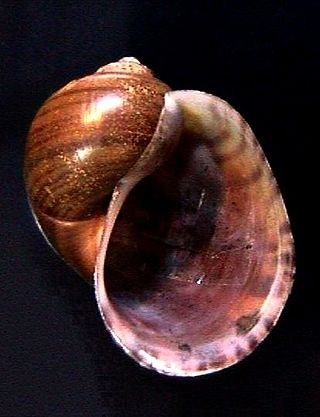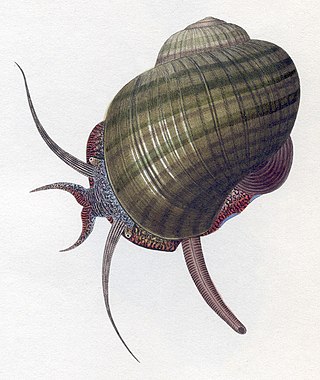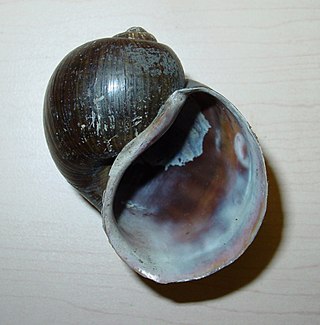Related Research Articles

Ampullariidae, whose members are commonly known as apple snails, is a family of large freshwater snails that includes the mystery snail species. They are aquatic gastropod mollusks with a gill and an operculum. These snails simultaneously have a gill and a lung as functional respiratory structures, which are separated by a division of the mantle cavity. This adaptation allows these animals to be amphibious. Species in this family are considered gonochoristic, meaning that each individual organism is either male or female.

Among animals which produce eggs, the yolk is the nutrient-bearing portion of the egg whose primary function is to supply food for the development of the embryo. Some types of egg contain no yolk, for example because they are laid in situations where the food supply is sufficient or because the embryo develops in the parent's body, which supplies the food, usually through a placenta. Reproductive systems in which the mother's body supplies the embryo directly are said to be matrotrophic; those in which the embryo is supplied by yolk are said to be lecithotrophic. In many species, such as all birds, and most reptiles and insects, the yolk takes the form of a special storage organ constructed in the reproductive tract of the mother. In many other animals, especially very small species such as some fish and invertebrates, the yolk material is not in a special organ, but inside the egg cell.
A trypsin inhibitor (TI) is a protein and a type of serine protease inhibitor (serpin) that reduces the biological activity of trypsin by controlling the activation and catalytic reactions of proteins. Trypsin is an enzyme involved in the breakdown of many different proteins, primarily as part of digestion in humans and other animals such as monogastrics and young ruminants. Serpins – including trypsin inhibitors – are irreversible and suicide substrate-like inhibitors.
The vitelline membrane or vitelline envelope is a structure surrounding the outer surface of the plasma membrane of an ovum or, in some animals, the extracellular yolk and the oolemma. It is composed mostly of protein fibers, with protein receptors needed for sperm binding which, in turn, are bound to sperm plasma membrane receptors. The species-specificity between these receptors contributes to prevention of breeding between different species. It is called zona pellucida in mammals. Between the vitelline membrane and zona pellucida is a fluid-filled perivitelline space.

Pore-forming proteins are usually produced by bacteria, and include a number of protein exotoxins but may also be produced by other organisms such as apple snails that produce perivitellin-2 or earthworms, who produce lysenin. They are frequently cytotoxic, as they create unregulated pores in the membrane of targeted cells.

Pila is a genus of large freshwater snails with an operculum, African and Asian apple snails, aquatic gastropod mollusks in the family Ampullariidae, the apple snails.

Pomacea is a genus of freshwater snails with gills and an operculum, aquatic gastropod mollusks in the family Ampullariidae, the apple snails. The genus is native to the Americas; most species in this genus are restricted to South America.

Pomacea canaliculata, commonly known as the golden apple snail or the channeled apple snail, is a species of large freshwater snail with gills and an operculum, an aquatic gastropod mollusc in the family Ampullariidae, the apple snails. South American in origin, this species is considered to be in the top 100 of the "World's Worst Invasive Alien Species". It is also ranked as the 40th worst alien species in Europe and the worst alien species of gastropod in Europe.

Pomacea haustrum, common name the titan applesnail, is a species of large freshwater snail with an operculum, an aquatic gastropod mollusk in the family Ampullariidae, the applesnails.

Pomacea paludosa, common name the Florida applesnail, is a species of freshwater snail with an operculum, an aquatic gastropod mollusk in the family Ampullariidae, the apple snails.

The AB toxins are two-component protein complexes secreted by a number of pathogenic bacteria, though there is a pore-forming AB toxin found in the eggs of a snail. They can be classified as Type III toxins because they interfere with internal cell function. They are named AB toxins due to their components: the "A" component is usually the "active" portion, and the "B" component is usually the "binding" portion. The "A" subunit possesses enzyme activity, and is transferred to the host cell following a conformational change in the membrane-bound transport "B" subunit. These proteins consist of two independent polypeptides, which correspond to the A/B subunit moieties. The enzyme component (A) enters the cell through endosomes produced by the oligomeric binding/translocation protein (B), and prevents actin polymerisation through ADP-ribosylation of monomeric G-actin.

Pomacea maculata is a species of large freshwater snail with an operculum, an aquatic gastropod mollusk in the family Ampullariidae, the apple snails.

Galactogen is a polysaccharide of galactose that functions as energy storage in pulmonate snails and some Caenogastropoda. This polysaccharide is exclusive of the reproduction and is only found in the albumen gland from the female snail reproductive system and in the perivitelline fluid of eggs.
The perivitellinefluid is an extracellular fluid found in the eggs of most gastropods and constitutes the main source of nutrition and defense for their embryos. It replaces the egg yolk of other animals, which in snail eggs is reduced to non-nutritive proteinaceous granules with putative enzymatic function.
Ovorubin is the most abundant perivitellin of the perivitelline fluid from Pomacea canaliculata snail eggs. This glyco-lipo-caroteno protein complex is a approx. 300 kDa multimer of a combination of multiple copies of six different ~30 kDa subunits.
Pomacea maculata perivitellin-1 (PmPV1) is the most abundant perivitellin found in the perivitelline fluid from Pomacea maculata snail eggs. This glyco-lipo-caroteno protein is an approx. 294 kDa multimer of a combination of multiple copies of six different ~30 kDa subunits. PmPV1 account >60% of the total proteins found in the Pomacea maculata eggs.
Scalarin (PsSC) is the most abundant perivitellin of the perivitelline fluid from Pomacea scalaris eggs. This glyco-lipo-caroteno protein is an approx. 380 kDa multimer combining multiple copies of six different 24-35 kDa subunits.
Perivitellin-2 (PV2) is a pore-forming toxin present in the egg perivitelline fluid of the apple snails Pomacea maculata (PmPV2) and Pomacea canaliculata (PcPV2). This protein, called perivitellin, is massively accumulated in the eggs. As a toxin PV2 protects eggs from predators, but it also nourishes the developing snail embryos.

Pomacea columellaris is a South American species of freshwater snail in the apple snail family, Ampullariidae.
Temptin is a protein that acts as a water-borne pheromone in the marine gastropod mollusk Aplysia californica. It is an abundant protein that is synthesized in the albumen gland, and is released in the egg cords during oviposition, along with other proteins called attractin, seductin and enticin. Together, they make up a complex of water-soluble proteins that act together to attract mates for reproduction and induce spawning.
References
- 1 2 Heras H, Dreon MS, Ituarte S, Pollero RJ (2007-07-01). "Egg carotenoproteins in neotropical Ampullariidae (Gastropoda: Arquitaenioglossa)". Comparative Biochemistry and Physiology. Toxicology & Pharmacology. 146 (1–2): 158–67. doi:10.1016/j.cbpc.2006.10.013. PMID 17320485.
- ↑ Hayes KA, Burks RL, Castro-Vazquez A, Darby PC, Heras H, Martín PR, Qiu JW, Thiengo SC, Vega IA, Wada T, Yusa Y (2015). "Insights from an Integrated View of the Biology of Apple Snails (Caenogastropoda: Ampullariidae)". Malacologia. 58 (1–2): 245–302. doi:10.4002/040.058.0209. hdl: 11336/7919 . S2CID 85707576.
- ↑ Heras H, Dreon MS, Ituarte S, Pasquevich MY, Cadierno MP, Joshi RC, Cowie RH, Sebastian LS (2017). Apple snail perivitellins, multifunctional egg proteins. Philippine Rice Research Institute. ISBN 978-621-8022-25-6.
- 1 2 3 Cadierno MP, Saveanu L, Dreon MS, Martín PR, Heras H (August 2018). "Biosynthesis in the Albumen Gland-Capsule Gland Complex Limits Reproductive Effort in the Invasive Apple Snail Pomacea canaliculata". The Biological Bulletin. 235 (1): 1–11. doi:10.1086/699200. PMID 30160995. S2CID 52135669.
- 1 2 Sun J, Wang M, Wang H, Zhang H, Zhang X, Thiyagarajan V, et al. (November 2012). "De novo assembly of the transcriptome of an invasive snail and its multiple ecological applications". Molecular Ecology Resources. 12 (6): 1133–44. doi:10.1111/1755-0998.12014. PMID 22994926. S2CID 23653895.
- ↑ Dreon M, Lavarias S, Garin CF, Heras H, Pollero RJ (February 2002). "Synthesis, distribution, and levels of an egg lipoprotein from the apple snail Pomacea canaliculata (Mollusca: Gastropoda)". The Journal of Experimental Zoology. 292 (3): 323–30. doi:10.1002/jez.10043. PMID 11857466.
- ↑ Dreon MS, Heras H, Pollero RJ (January 2003). "Metabolism of ovorubin, the major egg lipoprotein from the apple snail". Molecular and Cellular Biochemistry. 243 (1–2): 9–14. doi:10.1023/a:1021616610241. PMID 12619883. S2CID 6345962.
- 1 2 3 Dreon MS, Heras H, Pollero RJ (July 2004). "Characterization of the major egg glycolipoproteins from the perivitellin fluid of the apple snail Pomacea canaliculata". Molecular Reproduction and Development. 68 (3): 359–64. doi:10.1002/mrd.20078. PMID 15112330. S2CID 22032382.
- ↑ Wijsman TC, van Wijck-Batenburg H (1987-09-01). "Biochemical Composition of the Eggs of the Freshwater Snail Lymnaea stagnalis and Oviposition-induced Restoration of Albumen Gland Secretion". International Journal of Invertebrate Reproduction and Development. 12 (2): 199–212. doi:10.1080/01688170.1987.10510317.
- 1 2 Garin CF, Heras H, Pollero RJ (December 1996). "Lipoproteins of the egg perivitelline fluid of Pomacea canaliculata snails (Mollusca: Gastropoda)". The Journal of Experimental Zoology. 276 (5): 307–14. doi:10.1002/(SICI)1097-010X(19961201)276:5<307::AID-JEZ1>3.0.CO;2-S. PMID 8972583.
- ↑ Sun J, Zhang H, Wang H, Heras H, Dreon MS, Ituarte S, et al. (August 2012). "First proteome of the egg perivitelline fluid of a freshwater gastropod with aerial oviposition". Journal of Proteome Research. 11 (8): 4240–8. doi:10.1021/pr3003613. hdl: 11336/94414 . PMID 22738194.
- ↑ Mu H, Sun J, Cheung SG, Fang L, Zhou H, Luan T, et al. (February 2018). "Comparative proteomics and codon substitution analysis reveal mechanisms of differential resistance to hypoxia in congeneric snails". Journal of Proteomics. 172: 36–48. doi:10.1016/j.jprot.2017.11.002. hdl: 10754/626132 . PMID 29122728.
- ↑ Ip JC, Mu H, Zhang Y, Heras H, Qiu JW (April 2020). "Egg perivitelline fluid proteome of a freshwater snail: Insight into the transition from aquatic to terrestrial egg deposition". Rapid Communications in Mass Spectrometry. 34 (7): e8605. doi:10.1002/rcm.8605. hdl: 11336/128840 . PMID 31657488. S2CID 204947433.
- ↑ Sun J, Mu H, Ip JC, Li R, Xu T, Accorsi A, et al. (July 2019). "Signatures of Divergence, Invasiveness, and Terrestrialization Revealed by Four Apple Snail Genomes". Molecular Biology and Evolution. 36 (7): 1507–1520. doi:10.1093/molbev/msz084. PMC 6573481 . PMID 30980073.
- ↑ Cheesman DF (December 1958). "Ovorubin, a chromoprotein from the eggs of the gastropod mollusc Pomacea canaliculata". Proceedings of the Royal Society of London. Series B, Biological Sciences. 149 (937): 571–87. Bibcode:1958RSPSB.149..571C. doi:10.1098/rspb.1958.0093. PMID 13623805. S2CID 44905224.
- 1 2 Heras H, Garin CF, Pollero RJ (1998). "Biochemical composition and energy sources during embryo development and in early juveniles of the snail Pomacea canaliculata (Mollusca: Gastropoda)". Journal of Experimental Zoology. 280 (6): 375–383. doi:10.1002/(SICI)1097-010X(19980415)280:6<375::AID-JEZ1>3.0.CO;2-K. ISSN 1097-010X.
- 1 2 Dreon MS, Ituarte S, Heras H (December 2010). "The role of the proteinase inhibitor ovorubin in apple snail eggs resembles plant embryo defense against predation". PLOS ONE. 5 (12): e15059. Bibcode:2010PLoSO...515059D. doi: 10.1371/journal.pone.0015059 . PMC 2997075 . PMID 21151935.
- 1 2 3 4 Dreon MS, Frassa MV, Ceolín M, Ituarte S, Qiu JW, Sun J, et al. (2013-05-30). "Novel animal defenses against predation: a snail egg neurotoxin combining lectin and pore-forming chains that resembles plant defense and bacteria attack toxins". PLOS ONE. 8 (5): e63782. Bibcode:2013PLoSO...863782D. doi: 10.1371/journal.pone.0063782 . PMC 3667788 . PMID 23737950.
- 1 2 3 4 Ituarte S, Dreon MS, Pasquevich MY, Fernández PE, Heras H (September 2010). "Carbohydrates and glycoforms of the major egg perivitellins from Pomacea apple snails (Architaenioglossa: Ampullariidae)". Comparative Biochemistry and Physiology. Part B, Biochemistry & Molecular Biology. 157 (1): 66–72. doi:10.1016/j.cbpb.2010.05.004. PMID 20471490.
- 1 2 Dreon MS, Ituarte S, Ceolín M, Heras H (September 2008). "Global shape and pH stability of ovorubin, an oligomeric protein from the eggs of Pomacea canaliculata". The FEBS Journal. 275 (18): 4522–30. doi: 10.1111/j.1742-4658.2008.06595.x . PMID 18673387. S2CID 22611520.
- 1 2 Frassa MV, Ceolín M, Dreon MS, Heras H (July 2010). "Structure and stability of the neurotoxin PV2 from the eggs of the apple snail Pomacea canaliculata". Biochimica et Biophysica Acta (BBA) - Proteins and Proteomics. 1804 (7): 1492–9. doi:10.1016/j.bbapap.2010.02.013. PMID 20215051.
- 1 2 Ituarte S, Dreon MS, Ceolin M, Heras H (2012-11-20). "Agglutinating activity and structural characterization of scalarin, the major egg protein of the snail Pomacea scalaris (d'Orbigny, 1832)". PLOS ONE. 7 (11): e50115. Bibcode:2012PLoSO...750115I. doi: 10.1371/journal.pone.0050115 . PMC 3502340 . PMID 23185551.
- 1 2 Ituarte S, Brola TR, Fernández PE, Mu H, Qiu JW, Heras H, Dreon MS (2018-06-01). "A lectin of a non-invasive apple snail as an egg defense against predation alters the rat gut morphophysiology". PLOS ONE. 13 (6): e0198361. Bibcode:2018PLoSO..1398361I. doi: 10.1371/journal.pone.0198361 . PMC 5983499 . PMID 29856808.
- ↑ Brola, T. R.; Dreon, M. S.; Qiu, J. W.; Heras, H. (2020-01-01). "A highly stable, nondigestible lectin from Pomacea diffusa unveils clade-related protection systems in apple snail eggs". Journal of Experimental Biology. 223 (19): jeb.231878. doi: 10.1242/jeb.231878 . hdl: 11336/144003 . ISSN 0022-0949. PMID 32719049. S2CID 220841934.
- 1 2 3 Pasquevich MY, Dreon MS, Heras H (March 2014). "The major egg reserve protein from the invasive apple snail Pomacea maculata is a complex carotenoprotein related to those of Pomacea canaliculata and Pomacea scalaris". Comparative Biochemistry and Physiology. Part B, Biochemistry & Molecular Biology. 169: 63–71. doi:10.1016/j.cbpb.2013.11.008. hdl: 11336/100510 . PMID 24291422.
- 1 2 Pasquevich MY, Dreon MS, Qiu JW, Mu H, Heras H (November 2017). "Convergent evolution of plant and animal embryo defences by hyperstable non-digestible storage proteins". Scientific Reports. 7 (1): 15848. Bibcode:2017NatSR...715848P. doi:10.1038/s41598-017-16185-9. PMC 5696525 . PMID 29158565.
- 1 2 3 Giglio ML, Ituarte S, Milesi V, Dreon MS, Brola TR, Caramelo J, et al. (August 2020). "Exaptation of two ancient immune proteins into a new dimeric pore-forming toxin in snails". Journal of Structural Biology. 211 (2): 107531. doi:10.1016/j.jsb.2020.107531. hdl: 11336/143650 . PMID 32446810. S2CID 218873723.
- 1 2 tuarte S, Brola TR, Dreon MS, Sun J, Qiu JW, Heras H (2019-02-01). "Non-digestible proteins and protease inhibitors: implications for defense of the colored eggs of the freshwater apple snail Pomacea canaliculata". Canadian Journal of Zoology. 97 (6): 558–566. doi:10.1139/cjz-2018-0210. hdl: 1807/95364 . ISSN 0008-4301. S2CID 92566772.
- ↑ Dreon MS, Schinella G, Heras H, Pollero RJ (February 2004). "Antioxidant defense system in the apple snail eggs, the role of ovorubin". Archives of Biochemistry and Biophysics. 422 (1): 1–8. doi:10.1016/j.abb.2003.11.018. PMID 14725852.
- 1 2 Heras H, Frassa MV, Fernández PE, Galosi CM, Gimeno EJ, Dreon MS (September 2008). "First egg protein with a neurotoxic effect on mice". Toxicon. 52 (3): 481–8. doi:10.1016/j.toxicon.2008.06.022. PMID 18640143.
- ↑ Giglio ML, Ituarte S, Pasquevich MY, Heras H (2016-09-12). "The eggs of the apple snail Pomacea maculata are defended by indigestible polysaccharides and toxic proteins". Canadian Journal of Zoology. 94 (11): 777–785. doi:10.1139/cjz-2016-0049. hdl: 1807/74381 .
- 1 2 Giglio ML, Ituarte S, Ibañez AE, Dreon MS, Prieto E, Fernández PE, Heras H (2020). "Novel Role for Animal Innate Immune Molecules: Enterotoxic Activity of a Snail Egg MACPF-Toxin". Frontiers in Immunology. 11: 428. doi: 10.3389/fimmu.2020.00428 . PMC 7082926 . PMID 32231667.